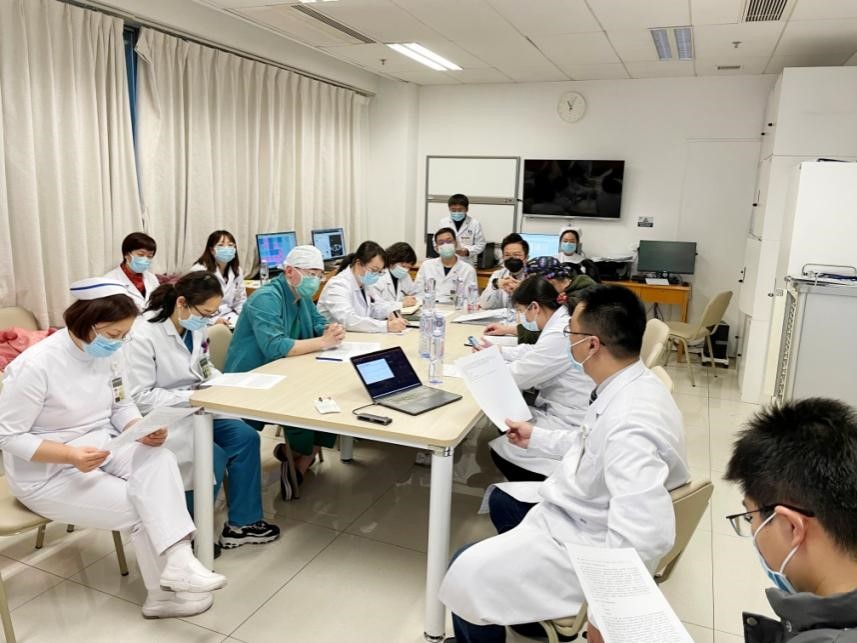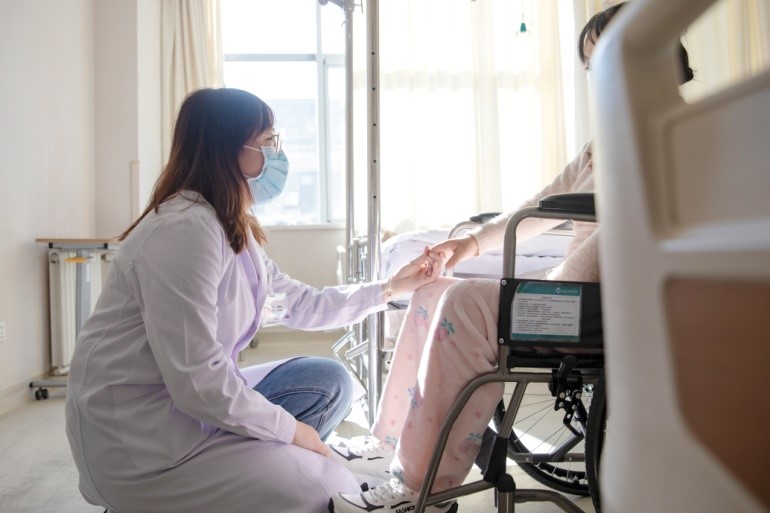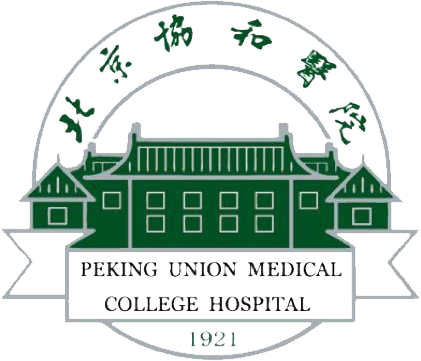On January 27, 2022, Miss Liu could finally be discharged from the hospital and go home for a worry-free Spring Festival, and she beamed a smile, for the first time in a long time. More than two months ago, the 18-year-old Miss Liu was urgently transferred to PUMCH due to purulent infection of the left hip joint with disseminated pneumonia, acute pulmonary embolism and septic shock. Under the overall coordination of the Department of Medical Affairs, PUMCH organized 5 multidisciplinary consultations that brought together the Department of Emergency, the Department of Medical Intensive Care Unit (MICU), the Department of Cardiac Surgery, the Department of Intensive Care Unit (ICU), the Department of Infectious Diseases, the Department of Orthopedics Surgery, the Department of Anesthesiology, the Department of Respiratory and Critical/Intensive Care, the Department of Otolaryngology, the Hospice and Palliative Care Medical Team, the Department of Psychological Medicine and the Department of Infection Control, and finally pulled the patient out of danger.
Sudden Pain in Left Thigh Worsened Quickly, Putting the Patient in Critical Condition
On October 25, 2021, Miss Liu suddenly felt pain in her left thigh when playing badminton after class as usual. Despite two visits to the local hospital, the pain was still not relieved, and Miss Liu could only rest in bed. In mid-November, Miss Liu suddenly developed the symptoms of wheezing and dyspnea. Her condition continued to worsen, accompanied by a drop in blood pressure and disturbance of consciousness. She received two-day symptomatic treatment at the local hospital, but saw no improvement in her condition. The speeding ambulance, carrying the hope of Miss Liu’s family, drove into PUMCH’s Department of Emergency.
Body temperature at 38.7°C, heartbeat of 130 beats per minute, deep sedation and analgesia... Every indicator showed that Miss Liu was in critical condition. Dr. Yang Jing in the emergency room suspected the patient of having pulmonary embolism. Under the guidance of Shi Juhong, Deputy Director of the Department of Respiratory and Critical/Intensive Care, and Xu Jun, Deputy Director of the Department of Emergency, Dr. Yang performed anti-shock and anti-infective treatment, and at the same time conducted etiological examinations such as blood culture and sputum culture, finished CT pulmonary angiogram (CTPA), and actively communicated with the Department of Medical Intensive Care Unit, to seek more opportunities for the follow-up treatment.
MDT Consultation to Clear the Obstacles in Treatment
Jiang Wei, Attending Physician of the Department of Medical Intensive Care Unit, assessed Miss Liu’s condition, and quickly admitted her to the ward. The physical examination found a heart murmur, and the echocardiography revealed tricuspid valve vegetation, tricuspid valve leaflet damage, and severe tricuspid valve regurgitation. At the same time, the patient’s blood culture alarmed positive, and the diagnosis of right heart infective endocarditis was made only 6 hours after admission. It is uncommon, and there must be a primary infection focus hidden in the dark. Weng Li, Director of the Department of Medical Intensive Care Unit, made a decisive prediction after the ward round that the hip joint may be the key point. On the second day after Miss Liu was admitted to the hospital, the Medical Intensive Care Unit team completed MRI of her hip joint with vasopressor support and simple respirator.
As Miss Liu’s condition was worsening rapidly, it was urgent to locate the focus of infection. Wang Chunyao, Attending Physician of the Department of Medical Intensive Care Unit, submitted the application for the first multidisciplinary consultation. Chang Xiao, Attending Physician of the Department of Orthopedics Surgery, performed aspiration on Miss Liu’s left hip joint under the guidance of bedside ultrasound. Given that no obvious abscess was found in the left hip joint, Dr. Chang suggested anti-infective treatment first instead of surgery. Liu Xinpei, a physician from the Department of Cardiac Surgery engaged in the consultation, suggested a valve surgery as soon as possible even if the septic shock caused by infection was under control, because the huge valve vegetation may fall off again any time, leading to fatal pulmonary embolism.
After performing the preoperative evaluation and excluding contraindications to operation, with the support from Hui Shangyi, Attending Physician of the Department of Anesthesiology, Miao Qi, Director of the Department of Cardiac Surgery, performed the operation with the patient under general anesthesia and cardiopulmonary bypass. Miao found that the root of the tricuspid valve leaflet and the subvalvular structure were severely damaged with extensive vegetation growing on them, and performed “tricuspid valve replacement”. The patient was returned to the ICU after operation.
The blood culture obtained during the cardiopulmonary bypass operation was still positive. On the one hand, the septic shock and acute respiratory distress syndrome (ARDS) continued to aggravate; on the other hand, multiple cavitary lung lesions caused by staphylococcus aureus infection led to secondary tension pneumothorax. The patient’s condition took a turn for the worse, and her life was hanging by a thread. Despite emergency placement of a chest tube, the oxygen saturation level was still low, and the patient may need extracorporeal membrane oxygenation (ECMO). Considering the income of the patient’s family, ICU Director Long Yun made a decision, performing prone position ventilation. Although this therapy may affect the drainage of the chest tube, it was still performed by Dr. Long, together with Assistant Director He Huaiwu and Physician Su Longxiang. Electrical impedance tomography (EIT) was applied to assess regional alveolar overinflation and collapse bedside, and esophageal pressure catheter was placed for transpulmonary pressure. Those treatments effectively protected the lungs. The patient’s breathing gradually improved a few hours after the operation, leaving more time for the anti-infection treatment to take effect. Miss Liu was successfully weaned from ventilator.
The Department of Infectious Diseases and the Department of Respiratory and Critical/Intensive Care joined hands to adjust the antibiotic regimen for the patient, and performed anti-infective treatment, respiratory support, diuresis and dehydration, and postural drainage, creating more space for the following key treatment.
With the Damaged Hip Joint Thoroughly Cleaned up, the Patient Recovered from Critical Condition and Beamed a Smile
The “accomplices” were defeated one by one, and it was the time to find out the “prime culprit”. The prominent symptom of the patient was pain in the left hip, the indicators of inflammation were not significantly improved, and CT and MRI showed that the damage on the left hip was progressively worsening. Considering those factors, the Department of Orthopedics Surgery decided to perform an operation for Miss Liu. Lin Jin, Chief Physician of the Department of Orthopedics Surgery had treated similar severe infections in the hip joint and offered to perform the operation, Dr. Lin performed thorough debridement of the damaged hip joint, and then placed a spacer made of antibiotics-loaded bone cement. The operation completed successfully.
During the hospitalization, the nursing teams of various departments took great care of Miss Liu. Li Zunzhu, ICU Head Nurse, and Gao Na, Head Nurse of the Department of Orthopedics Surgery, led their teams to formulate a personalized care plan. They carefully combed hair and washed face for Miss Liu every day and helped relieve her tension and anxiety. Considering that Miss Liu cannot speak well in the early postoperative period, they thoughtfully made small cards for better communication, making the patient feel the warmth of PUMCH everywhere.
When discharged from the hospital, Miss Liu could move her left hip independently. “I am very happy. When I get home, I will draw a picture on my drawing board to express my sincere gratitude for doctors and nurses.”
In addition to the cooperation between the multidisciplinary professional teams, the medical social workers funded by the Peking Union Medical Foundation also actively followed up the treatment, assisted in contacting the Hospice and Palliative Care MDT for a consultation, and helped the patient with eligibility for the aid for poverty-stricken patients, providing Miss Liu and her family with attentive medical social service. Shifting from a “doctor-centered” approach to a “patient-centered” approach, PUMCH has always stayed committed to its original aspiration, dared to explore and innovate, opened up the channels for saving life, and better served the public with superb medical care.

Multidisciplinary consultation

Medical social workers followed up the whole process of treatment
Reporter: Wang Jingxia
Correspondent: Liu Jinhan
Picture: Sun Liang and the Department of Medical Affairs
Translator: Liu Haiyan
Editor: Tian Xinlun, Ding Xin, Wang Wei and Wang Yao
